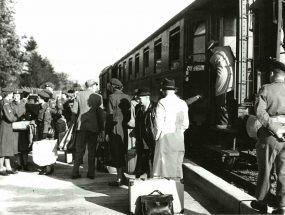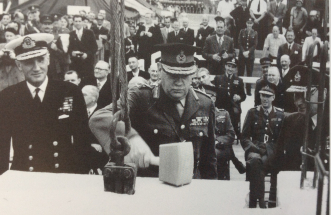| An article from the website of Moenchengladbach describing the events that took place at JHQ in July 2013 to celebrate the closure of the Garrison. See below for English translation of the article!
|
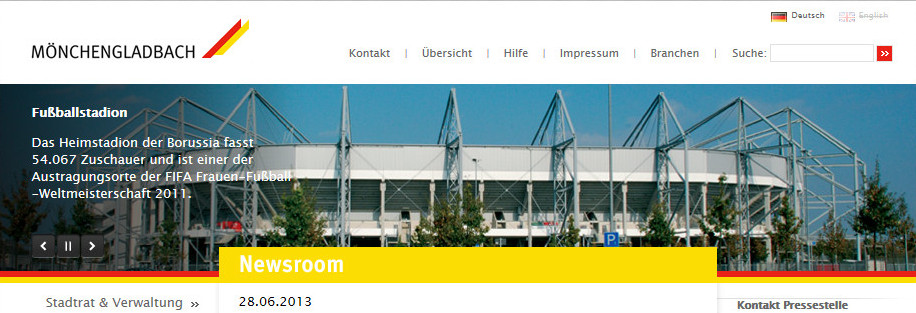 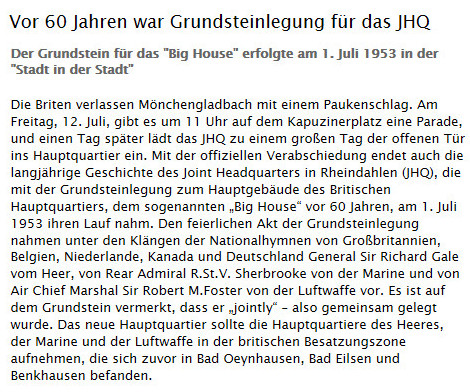 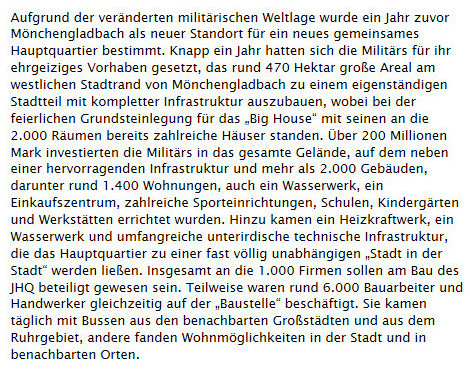
|
| Sixty years ago was the laying of the cornerstone for JHQ
The cornerstone for the “Big House” was laid on the 1st July 1953 in the “Town within a town” The British leave Moenchengladbach with a bang. On Friday, 12th July 2013, there will be a parade on Kapuzinerstrasse and one day later JHQ is inviting all to a big “open day” celebration in the headquarters. The official closing ceremony will bring to an end the long history of the Joint Headquarters in Rheindahlen, which began with the laying of the cornerstone for the “Big House”, 60 years ago, on the 1st July 1953. The ceremonial laying of the cornerstone took place to the sound of the national anthems of Great Britain, Belgium, the Netherlands, Canada and Germany and in the presence of General Sir Richard Gale (British Army), Rear Admiral Robert St Vincent Sherbrooke (Royal Navy) and Air Chief Marshall Sir Robert Mordaunt Foster (Royal Air Force). It is noted on the cornerstone that is was “Jointly” laid to indicate that the new headquarters was to be the joint headquarters in the British Occupation Zone for the British Army of the Rhine, the Royal Navy and the Royal Air Force, who were previously based in Bad Oeynhausen, Bad Eilsen and Benkhausen. Due to the changing military situation in 1953 a decision was taken, a year earlier, to build a new joint headquarters in Moenchengladbach. The military had ambitious plans to develop almost 470 hectares of woodland in Rheindahlen into an independent part of the town with its own infrastructure. Approximately 200 million D-Mark were invested in the construction of an excellent infrastructure, more than 2,000 buildings, a shopping center, several sports facilities, schools, kindergardens and workshops. A power station, water works and extensive underground technical infrastructure were added which made the headquarters into a completely independent “Town within a town”. Almost 1,000 companies participated in the building of JHQ with up to 6,000 builders and construction workers employed. Many came in buses from many of the surrounding cities and the Ruhrgebiet while others found accommodation in Moenchengladbach and the surrounding area. After a delay of 3 months, on the 4th October 1954, the “Headquarters of the Northern Armed Forces of Central Europe”, which was the name given to the headquarters at the time, was officially commissioned. Three days earlier, on the 1st October 1954, the first train transporting British soldiers from Bad Oeynhausen arrived at the railway station in Rheindahlen. The transfer of almost 12,000 people was completed within a few weeks. In only two months the transfer was complete. “We hope that you will soon settle in and feel at home in our town, that a good relationship will soon establish itself on a cultural, sporting and, above all, personal level, and that this important date will be the start of a happy and peaceful period” said the Mayor of that time, Dr. Wilhelm Finger, and the Senior Town Director, Dr. Wilhelm Fleuster. Sixty years later, on the 12th and 13th July 2013, this chapter in the history of Moenchengladbach will end. (pmg/sp) Translation by Fred Williams |

